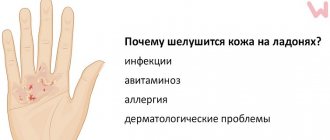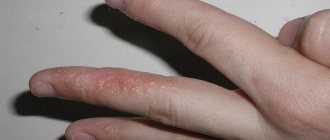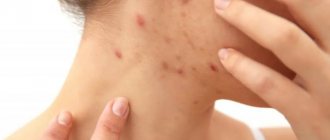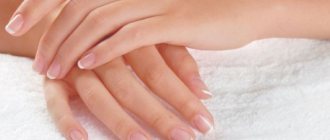In most cases, watery blisters on the palms are itchy and also cause aesthetic discomfort in humans. The appearance of such symptoms can be triggered by the development of a serious pathology that requires immediate attention. Therefore, as soon as watery, itchy subcutaneous blisters appear on the palms without visible preconditions, you need to consult a dermatologist.
Timely diagnosis and the correct course of treatment will stop the transition of the initial stage of the disease into a chronic form.
Clinical picture of dyshidrosis
Dyshidrosis is considered a chronic skin disease. Exacerbation occurs in spring and autumn. Pathology usually appears unexpectedly, but with enviable regularity. Dyshidrosis is characterized by single or group small subcutaneous rashes ranging in size from 1 to 4 mm. Over time, they can increase to the size of a pea and merge into one large blister. The blisters have a dense shell and are filled with serous fluid. It is believed that they are a consequence of blockage of the sweat gland ducts.
Dyshidrosis is also called dyshidrotic eczema. The pathology is popularly known as dropsy.
The rashes are localized mainly on the palms and soles, less often on the fingers and the back of the limbs. They are often accompanied by increased sweating. Usually the patient discovers a new vesicle by accident: only after scratching the itchy spot does he feel a lump on the surface of the skin. The clinical picture is complemented by severe itching, redness, swelling and a slight burning sensation.
Dyshidrosis is not contagious, but it looks unsightly and causes discomfort to the patient. It can be diagnosed in a person at any age, including children. More common in women. The disease is independent in nature and acts as one of the symptoms of some dermatoses, such as mycoses and toxicoderma.
Causes of blisters on the palms not related to disease
The negative impact of external factors does not pose a threat if the damage to the hands is minor. But the affected area must be kept clean and bacteria must not be allowed to enter. The main reasons for the appearance of pimples are:
- Burn. The impact can be thermal (open fire, steam, boiling water, hot objects) and chemical (acids, alkalis, salts). When a burn occurs, large or small blisters appear on the palms, itch and crack, releasing a colorless liquid. In case of injury, the remaining chemical components should be washed off with warm water; in case of a thermal burn, your hands should be held under a cold stream.
- Mechanical impact. Calluses appear as fluid-filled blisters or hard bumps. They pass on their own.
Possible complications
When scratching or opening the rash on your own, there is a high risk of pathogenic microorganisms getting inside. This leads to an inflammatory process: the blisters turn into pustules. The liquid inside them loses its transparency, acquiring a yellowish color. The discomfort intensifies, severe swelling appears. In some cases, the patient experiences an increase in body temperature.
Other complications of hand dyshidrosis include panaritium and lymphangitis: purulent inflammation of the finger and lymphatic vessel, respectively. In the latter case, a painful cord forms under the skin.
Allergic diseases, dermatoses
The appearance of unpleasant symptoms is mainly noticeable in spring and summer. At this time, the air is saturated with allergens, the heat causes increased sweating, and insect bites cause skin irritation.
Allergies and dermatitis
If pimples appear on the palms and itch, this may indicate contact with sensitizing agents or their entry into the body.
External allergens:
- plants,
- animals,
- building mixtures, paints,
- detergents,
- caring cosmetics,
- medicines (ointment, patch),
- fuels and lubricants,
- metal, polymers,
- airtight work gloves.
Indoor allergens:
- food, drinks,
- medicines, dietary supplements.
Read also: Ointment for itching in the anus, suppositories for anal itching: names, treatment
Children often have itchy palms and insect bumps. Children examine beetles, worms, caterpillars, and ants in their hands, and then suffer from itching. The rash may be accompanied by swelling.
Pemphigus or bullous dermatitis
This is a hereditary disease that manifests itself gradually. First, the bubbles are visible on the mucous membrane of the mouth, scalp, then spread to the palms and soles.
The disease poses a serious threat in terms of infection through erosions that occur at the site of burst blisters.
Pathology can appear immediately after birth or in old age. Provoking factors are increased body temperature, overheating from warm clothing, and active physical activity.
The distinctive features of pemphigus are:
- watery pimples of different sizes,
- localization on thin skin,
- burning and itching without redness,
- increased discomfort before menstruation,
- rapid healing of erosions if they are not infected.
At the slightest injury to the skin, blisters appear on the palms, itch, and water fillings come out, forming weeping wounds.
When a pathology is diagnosed, patients receive different groups of disabilities depending on the severity of the disease.
Pustular psoriasis
Manifestations of the disease are:
- yellowish blisters located deep under the skin,
- pain in the palms,
- severe itching and burning,
- redness of the skin.
When the disease occurs, the blisters do not open, but gradually become covered with a dark crust.
The risk group includes people 40-50 years old, mainly women. Provoking factors are:
- genetic predisposition to psoriasis,
- smoking,
- high humidity during hot weather,
- stress,
- liver dysfunction.
Causes of hand dyshidrosis
Dyshidrosis as an independent disease was studied and described in detail back in 1873. However, its pathogenesis and etiology have not yet been fully established. What is known is that this disease has many causes.
Scientists believe that the development of dyshidrosis is promoted by:
- metabolic disease;
- decreased immunity;
- nervous stress;
- emotional instability;
- autoimmune conditions;
- predisposition to allergies;
- diseases of internal organs;
- mental and physical fatigue;
- taking certain medications, often antibiotics;
- frequent contact with household chemicals.
In some cases, it is problematic to identify the true causes of dyshidrosis. Then the disease takes a chronic form, exacerbating from time to time. This outcome is also caused by delaying a visit to a dermatologist and self-prescribing medications.
Viral diseases and parasites as the cause of itchy blisters on the palm
This group of pathologies is dangerous because it is transmitted from the affected organism and causes complications without proper therapy.
Infectious pemphigus
There is a high risk of infection in people whose professional activities involve contact with dead animals. These are butchers, slaughterhouse workers. The main symptoms of infection are:
- purulent or bloody blisters on the palms that itch and burst,
- heat,
- inflammation of the lymph nodes,
- severe malaise.
The disease is dangerous due to the septic process.
Scabies
A contagious skin disease caused by the scabies mite. The red rash concentrates first between the fingers, then spreads throughout the body. It can take up to one and a half months from tick entry to the appearance of the first symptoms.
Read also: Itchy stomach, causes of itchy sides in women, men, treatment
Scabies is difficult to treat, and it can take several weeks from the moment you use medication to eliminate the itching and get rid of pimples.
Herpes
The causative agent of the virus is present in most people, but does not manifest itself in any way until the onset of favorable conditions. This is a decrease in immunity, colds, pregnancy.
Watery blisters that appear on the palms itch and burn. In their place, yellowish ulcers form.
Chickenpox, rubella, measles
Infections are characterized by the appearance of small blisters. Their differences can be seen in the photo.
Children and adolescents usually suffer, but adult diseases, including repeated ones, cannot be ruled out. The infection is accompanied by a high temperature, a strong cough and difficulty breathing are possible, so you should definitely call a doctor at home.
Treatment of dyshidrosis
Therapeutic therapy for the disease is prescribed after determining the cause of its occurrence. It requires an integrated approach, since it is aimed not only at eliminating external manifestations of dyshidrosis and discomfort, but also at strengthening the immune system. In the first case, hormonal ointments containing corticosteroids are prescribed externally, and diuretics and antiallergic drugs are prescribed internally. If the blisters become infected, antibacterial drugs are prescribed. Treatment is carried out at home, but always under the supervision of a dermatologist.
The use of hormonal ointments accelerates the maturation of the vesicles. The larger they are, the more painful and longer they take to heal. After maturation, the bubbles burst, and dyshidrosis enters a regressive stage. It is accompanied by peeling and roughening of the skin, the formation of crusts and shallow cracks. The formation of new rashes is not observed. The affected area of the hand gradually begins to be covered with a renewed layer of epidermis.
When stress and emotional turmoil become the cause of dyshidrosis, the main emphasis in treatment is on restoring the nervous system. To do this, the doctor includes in the therapy the use of sedatives - adaptogens and nootropics.
Often, the treatment regimen is supplemented with adsorbents, including activated carbon, polyphepane, sorbex, etc. These products allow you to cleanse the body of toxins.
The list of auxiliary measures that can affect the outcome of treatment for dyshidrosis includes:
- regular walks in the fresh air;
- change in diet;
- hardening;
- use of gloves when in contact with household chemicals.
Dyshidrosis is difficult to cure completely: some time after recovery, the disease recurs.
In the treatment of dyshidrosis of the hands, non-traditional methods are widely used: acupuncture, hirudotherapy, apitherapy. The use of folk remedies is also acceptable. Dermatologists have nothing against hand baths based on medicinal herbs, such as string, sage, St. John's wort, oak bark or chamomile. Unlike drug treatment, traditional medicine is not as effective, but it is quite capable of reducing discomfort in the form of itching.
Symptoms and causes of rash
If there is a disturbance in the body, it signals this through the skin, which is manifested by dryness, discoloration or the formation of a rash. Rashes come in the form of spots, ulcers, blisters and nodules. In medicine, the general name for such symptoms is exanthema. A blistering rash (vesicles) is easy to distinguish: a small bump appears above the surface of the skin, which contains a clear or purulent serous fluid, which is characteristic of pustules.
Such formations can be the result of both mechanical damage to the skin, infections and autoimmune diseases. Pemphigus is one of the dangerous causes of rash that requires treatment. This is a rare autoimmune disease in which the rash occupies large areas of the body, including the mucous membranes. The rash may peel off, with individual vesicles of different sizes merging into a single area. With such symptoms, the patient urgently needs hospitalization. Similar symptoms may occur with psoriasis. Although in this case the patient is not in danger, you need to contact a dermatologist to confirm the diagnosis.
Content:
- Symptoms and causes of rash
- What to do if you have rashes
There are also more serious diseases in which blisters also appear on the skin. Another autoimmune disease with blistering rash is bullous pemphigoid. Appears only in elderly people. The vesicles cover only the skin, red spots appear between the pimples, and the exanthema feels thickened to the touch. If the rash is accompanied by symptoms of an eating disorder (bloating, vomiting, diarrhea, etc.), it may be dermatitis herpetiformis. In this case, the rash starts from the elbows and knees, buttocks, and the back of the head.
In addition to the main symptom of vesicular exanthema, there are a number of accompanying symptoms. This could be fever, itching, or lack of appetite. This set of symptoms is determined by the very reason why the rash appeared. The most common causes of blistering rashes on the body:
- Miliaria is a painful skin condition in which many vesicles appear in closed areas of the body and skin folds. The disease manifests itself after overheating, friction and sweating. With prickly heat, the rash is localized under the breasts, in the buttock cavity, and in the groin folds. In children, this disease manifests itself in different parts of the body. Without treatment and prevention, the vesicles fester.
- Infections. Vesicles often appear with chickenpox, rubella, scarlet fever, and measles. If along with the rash the temperature rises, the lymph nodes become enlarged, and the tonsils become inflamed, the cause is most likely an infection. Avoid scratching the vesicles as they may leave scars after healing.
- Herpes is a viral disease that differs from others in the location of the rash. Most often, with herpes, rashes in the form of blisters appear on the lips, in the nasolabial folds, and less often on the genitals. One or more vesicles filled with clear liquid are formed on the body, and a red rim appears around the tubercle. At first, the rash is itchy and hot to the touch. Such symptoms heal within a week without leaving any traces. Bubbles on the mucous membranes and genitals should be treated by a specialist.
- Stomatitis is the appearance of vesicles in the mouth. It may also be accompanied by fever, lethargy, inflammation and enlarged lymph nodes.
- Scabies is a disease caused by a mite. The pathogen is transmitted through household and sexual contact, in natural conditions. Small bubbles appear between the fingers, on the palms, and genitals. The appearance of vesicles is preceded by a rash in the form of spots, in place of which tubercles with liquid gradually form, which are easily infected by mechanical irritation. Treatment takes place only under the supervision of a dermatologist.
- Allergies and insect bites are the most common and less dangerous causes of blistering rash. In this case, vesicles can appear in any part of the body, sometimes they unite and occupy a large surface of the skin. A distinctive feature of such vesicles is severe itching, causing discomfort and affecting overall well-being. For allergy sufferers, symptoms go away after taking antihistamines. Insect bites must be treated with antiseptics, alcohol or iodine.
In addition to these reasons, vesicular rash appears from scratches and cat bites. This is called felinosis, when when human skin is damaged, the animal infects the wound. The first signs appear after 2 weeks; a thickening with a red tint is noticeable at the site of damage. Then a vesicle forms in the same area, the lymph nodes enlarge, and the temperature rises.
Coxsackie virus: calm, only calm
The news of an outbreak of infection with this virus shook up the ranks of vacationers in hot countries and their compatriots spending the summer at Russian resorts. Citizens frightened by the “epidemic” are hastily looking for a panacea, and those who have a vacation ahead of them, in a panic, decide to completely abandon the tours to the coast purchased in advance. And if you cool down and calmly figure out what kind of virus this is with the mysterious name Coxsackie and what disease does it cause?
Who is Coxsackie?
These enteroviruses were discovered by chance in 1949, when American scientist Gilbert Dalldroff was testing the feces of polio patients to create a cure or vaccine. The attempt to create a cure for polio failed, but Dalldroff went down in history as the discoverer of enteroviruses, to which he gave the name Coxsackie - after the small town on the Hudson River, from where the scientist received the first samples of material for research.
Despite the rather exotic sounding name, Coxsackie viruses do not represent anything extraordinary. These are common enteroviruses that thrive in the human gastrointestinal tract. They are distributed throughout the world, their activity depends on the season and climate.








